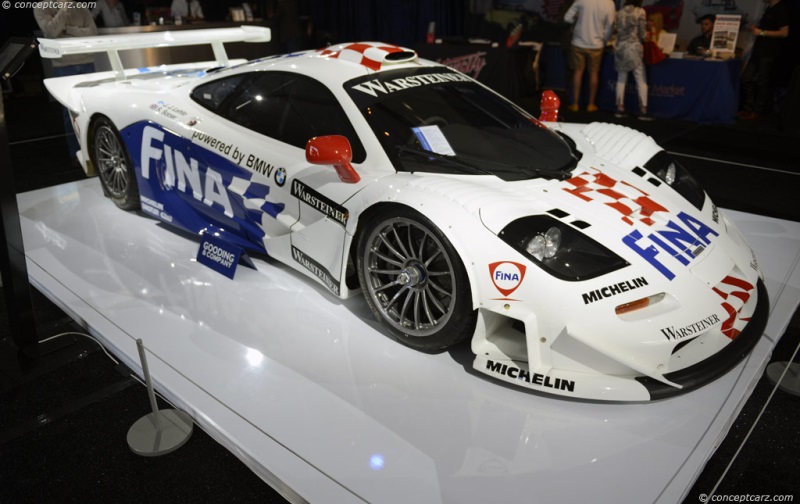From humble and simple beginnings, the company founded by New Zealander Bruce McLaren in 1963 would achieve greatness at the highest levels of motorsports competition and have a profound and history-changing effect in each of the sports it competed in and the road-going cars it built. They dominated the Can-Am series from 1967 to 1971, won the Indianapolis 500 in 1972, 1974, and 1976, and won the Formula One Constructors' Championship eight times (including 183 race victories) and the Drivers' Championship twelve times. 
Coupe
Chassis #: 21R
View info and history
Auction entries : 1From the beginning of his racing venture, Bruce McLaren wanted to compete in endurance events like the 24 Hours of LeMans with a closed GT car. His first solid attempt at accomplishing this goal was with the M6GT, so named (perhaps) in tribute to the M6A that began McLaren's initial success since the M6GT was based on the 1969 Can-Am chassis. It had a full interior, a flowing roofline, and was powered by a 5.7-liter Chevrolet V8 engine. Top speed was estimated at 165 mph, and zero to 100 mph was accomplished in eight seconds. Its racing career, however, ended before it even began, becoming ineligible after the FIA changed the rules, requiring a minimum of 50 production cars for a model to be homologated. This was an impossible task for the young company, and they would have to wait a quarter-of-a-century before Bruce's dream would finally come to life in the McLaren F1 Road Car, which went on to win Le Mans in 1995. The McLaren F1 was the world's fastest car by a wide margin for more than a decade (it remains the fastest naturally aspirated production car, with a top speed of 240 mph) and was endowed with engineering feats seemingly lifted directly from competition cars. The supercar's design was heavily influenced by the F1 race cars, earning it the now-iconic moniker, McLaren F1. It was the first vehicle to feature a monocoque composed of ultra-light-weight carbon fibre, and exotic materials such as Kevlar, titanium, gold, and magnesium were used for many components. Production of the McLaren F1 began in 1992 and ended in 1998 after 106 examples had been produced. This figure includes 62 road cars and 5 prototypes, 5 F1 LM examples and 1 prototype, 2 F1 GT examples and 1 prototype, 2 F1 HDK examples, and 28 F1 GTR examples. 
Coupe
Chassis #: 21R
View info and history
Auction entries : 1The McLaren F1 was designed by the legendary Gordon Murray, Ron Dennis, and the McLaren team as a road-going car, perhaps best known for its highly unusual three-seater configuration, with a central driver's seat plus a passenger seat on either side and slightly behind. The 6.0-liter BMW S70/2 V12 engine delivered 618 horsepower and was mated to a six-speed transmission. Almost immediately, the McLaren engineers and design team were pushed to create a racing equivalent. In 1995, McLaren took the F1 GTR to Le Mans where it took first, third, fourth, and fifth place. It also won the GT championship. Following its unprecedented success at Le Mans for a first-time entry, the McLaren F1 GTRs also won the 1000-kilometer race at Suzuka and the 4-Hours of Silverstone. In 1996, 1997, and 1998, McLaren GTRs again took on the challenge of LeMans, finishing 4th, 2nd, and fourth overall in 1996, 1997, and 1998 respectively. In over 120 races, the F1 GTR won 38 times and captured the pole position on six occasions. In celebration of its accomplishments at LeMans, the company built five limited-edition LM models, representing each of the F1 GTRs that finished the race. The LM received the most powerful engine of any F1, road or race, by using the GTR engine without air restrictors. Additionally, it used the race car aerodynamics, 18-inch wheels, and gearbox. All of the F1 LMs were painted as a tribute to the memory of Bruce McLaren - in the same Papaya Orange that was used on his contemporary Formula One and Can-Am cars.The BPR Global GT Series
The BPR Global GT Series operated from 1994 to 1996 and used production sports cars that were modified into racing cars. Rules required manufacturers to build a certain number of production cars for sale, with the number of homologation vehicles set by the class in which the car wished to participate. During the 1995 season, there were four classes (GT1 through GT4), shrinking to two in 1996 (GT1 and GT2). The upper classes were reserved for production vehicles that had undergone extensive modifications, including the use of non-production parts.
Coupe
Chassis #: 21R
View info and history
Auction entries : 1For the 1997 season, the BPR Global GT Series became the FIA GT Championship.The McLaren F1 GTR
The McLaren F1 was designed to be the best road-going sports car in the world and was never intended for competition, but priorities changed with the introduction of the BPR Global GT Series in 1994. This new series was an international endurance racing championship for production-based sports cars, and with mounting pressure from BPR organizers and well-funded private teams, Murray finally agreed to develop the F1 into a racing car. As expected from such a sophisticated machine, the race-prepared McLaren F1s dominated BPR's GT1 category, winning the championship in 1995 and 1996. After the 1996 season, the BPR Global GT Series reformed into the FIA GT Championship, and the regulations were altered to allow a new breed of GT1 car. Thus, the McLaren would have to compete directly with homologation specials like the Porsche 911 GT1 which had been designed especially for endurance racing. This meant more development work for the F1 GTR, which ultimately led to the creation of the F1 GTR 'Longtail.' Transforming the F1 into the F1 GTR
Although designed for the road, the McLaren F1 was built similarly to a race car, and did not require extensive modification to actually transform it into a racing car. An adjustable fixed wing was added to the rear of the car, and various cooling ducts were added, most noticeably a large one in the center of the nose. Two additional cooling ducts were placed in the location of the storage lockers on the side of the car.
Coupe
Chassis #: 21R
View info and history
Auction entries : 1The Engine
The road-going McLaren F1 was powered by a 6,064cc 60-degree V12 engine designed and built by engine expert Paul Rosche, head of the BMW M motorsport division. Called the BMW S70/2, it had dual overhead camshafts with variable valve timing, a chain drive for the camshaft, dry sump oil lubrication, 11:1 compression, two Lucas injectors per cylinder, and produced 618 horsepower at 7,400 RPM and 479 lb-ft of torque at 5,600 RPM. Magnesium castings were used for the dry sump, oil sump, cam carriers, covers, and housings for the camshaft control. Gold foil was used to line the engine bay as a heat reflector, and each car had approximately 16 g of gold. Each cylinder bore received a Nikasil coating for greater durability. The F1 GTR engine was required to use an air restrictor due to racing regulations at the time. This limited output to 592 horsepower (600 PS / 441 kW0), which meant it was less powerful than its road-going sibling. Due to its lower overall weight and aerodynamic modifications, the F1 GTR was faster and more nimble than the more powerful F1 road car.
Coupe
Chassis #: 21R
View info and history
Auction entries : 1The F1 GTR retained the Butterfly doors, central seating position, and standard gearbox of the F1, stripped out all non-essential luxuries, and added a full racing cage. Chassis 019 - the Developmental Prototype
McLaren built nine chassis for 1995, with chassis number 01R being the prototype. It was retained by the factory as a test mule and was used during a 24-hour test at Magny-Cours before the start of the season. Its sole competitive outting was at LeMans in 1955 when it was raced by Kokusai Kaihatsu Racing to overall victory. It also set the highest practice top speed of the year, achieving 174.605 mph on the Mulsanne Straight. F1 GTR Racing Chassis
The British team GTC Racing initially received two F1 GTRs, then a third to replace a destroyed car. BBA Competition, Mach One Racing, David Price Racing, and Giroix Racing Team each received a single chassis, and the final chassis (chassis number 09R) was sold to the Sultan of Brunei (Hassanal Bolkiah), for his car collection.
Coupe
Chassis #: 21R
View info and history
Auction entries : 1For the 1996 season, nine more new GTRs were built with additional modifications. Updates were made to the front and rear bodywork, with a larger splitter added to the front of the car. The bodywork could now be removed easier and quicker for repair. A lighter magnesium housing and more robust mechanicals were added to the gearbox. The overall weight was reduced by 38 kg and with its 330 km/h on the Mulsanne Straight at Le Mans in 1996, it was the fastest variant in terms of straight-line speed (the 1997 long-tail F1 GTR was 13 km/h slower.)Two of the 1995 cars (chassis number 03R and 06R) were updated to the 1996 specification.Ten additional GTRs were built for the 1997 season, with none of the previous cars updated to 1997-specs. The McLaren F1 GTR Longtail
Increased competition and rule changes birthed a dramatically different F1 GTR for the 1997 season. Porsche had its 911 GT1, Mercedes-Benz its CLK-GTR, Lotus its Elise GT1, and Panoz its Eserante GTR-1. With the FIA's taking control of the BPR Global GT Series, the GT1 class rules were altered. In addition to the ten F1 GTRs built to take advantage of the new rule changes, McLaren was forced to build an additional three production road cars (known as the F1 GT) using the 1997-spec GTR bodywork. The 1997-spec GTRs are commonly known as the 'Long Tail' due to their elongated bodywork, especially at the rear.
Coupe
Chassis #: 21R
View info and history
Auction entries : 1Extensive modifications to the bodywork were once again applied to the F1 GT, with a much longer nose and tail, a wider rear wing, widened wheel arches, and the ground clearance was changed to 2.76 inches front and rear (changed from 2.36 inches at the front and 3.15 inches at the rear). These revisions increased the aerodynamic downforce, and the wider arches allowed for wider tires allowed by the rules.The carbon-fiber monocoque chassis remained the same as the road car, but the engine was given extensive modifications, with the stroke being reduced to 5,990 cubic centimeters (366 cubic inches) to help increase durability and longevity. It continued to produce the air restrictor-controlled 600 metric horsepower, and the gearbox was replaced with a new X-trac 6-speed sequential transmission. Major teams that used the F1 GTR 'Long Tail' during the 1997 season included Team Davidoff, Parabolica Motorsports, and the BMW Motorsport-backed Schnitzer Motorsport. Privateers campaigned the older 1995-spec and 1996-spec cars.
Coupe
Chassis #: 21R
View info and history
Auction entries : 1At the opening round, the F1 GTR Longtail took a 1-2-3 victory ahead of six 911 GT1s. At the next round, BMW Motorsports F1 GTR edged out the Mercedes-Benz CLK-GTR by less than a second. The BMW Motorsport McLaren took the victory at the next round at Helsinki. By this point in the season, Mercedes-Benz had perfected its CLK-GTR and would claim a 1-2 victory at the Nürburgring, ahead of five McLarens. McLaren was able to secure a victory at Spa, but Mercedes took 1-2 victories in the next three rounds. A final victory for McLaren was earned at Mugello before the Mercedes took the final two victories of the year.BMW Motorsport finished second in the teams championship in 1997, scoring McLaren's only victories that year. Team Davidoff took a distant third.
Coupe
Chassis #: 027R
View info and historyAt the end of the 1997 season, BMW abandoned the McLaren F1 GTR project and turned its attention to constructing its own Le Mans Prototype project, the BMW V12 LM. Unable to compete against the CLK-LM, McLaren pulled out its factory support at the end of the 1997 season. Team Davidoff and Parabolica Motorsports, aligned with BBA Competition, contested the 1998 season with 1997-spec cars. Team Davidoff would finish 6th in the teams championship and was the only team to score points that season. At the end of the 1998 season, the GT1 class was abolished and the McLaren F1s never raced in FIA GT again. Beyond the BPR Global GT Series and the FIA GT Championship
Along with the BPR Global GT Series and the FIA GT Championship, the McLaren F1 GTR also contested the All Japan Grand Touring Championship (in 1996, 1999, 2000, 2001, 2002, and 2003) and the BRDC GT Championship (in 1996, one race in 1997, 1998, and 1999). As previously stated, the F1 GTR also raced (and won) the 24 Hours of Le Mans, which was officially not part of any one racing series. At Le Mans, the F1 GTR competed against a variety of cars, including GT1 competitors, unique cars that only raced at Le Mans, and competitors from various series.
Coupe
Chassis #: 027R
View info and historyAt the end of the 1996 season, Bigazzi Team SRL, Giroix Racing Team, and David Price Racing raced their F1 GTRs in Brazil at Curitiba and Brasília. The Bigazzi Team SRL won both races in 1996 ahead of the other two McLarens. Bigazzi returned to Brazil in 1997 and won at the Mil Mil Milhas.During 1997, Team Davidoff raced at the 6 Hours of Vallelunga with drivers Thomas Bscher and John Nielsen, winning 21 laps ahead of the nearest competitor. It placed second in the combined heat races at the Le Mans Autumn Cup, and earned another second in the FIA GT exhibition event at Zhuhai (China). In 1998, Davidoff raced in the opening round at Jarama (earning a victory) and then raced a week later at the opening round of the 1998 Italian GT season, the 1000km of Monza. Against fierce competition from open cockpit prototypes, Davidoff's McLaren convincingly won the race by an eleven-lap margin. GTR Euroseries
Created as an alternative to the international FIA GT Championship and combining elements of the former BPR Global GT Series, the GTR Euroseries raced just one season - 1998. It was created by Patrick Peter and the GTR Organisation, former founders of the BPR. It retained elements of the BPR Global GT Series, such as the class structure (GT1, GT2, GT3, and GT4), all events being four hours in length, and a ban on direct manufacturer input. Instead, this series was intended for small private teams who were seeking alternatives to the high-cost FIA GT series. Thomas Bscher won the first round of the season in Jarama in a McLaren GT GTR (GT1 class competitor). The next race did not feature the McLaren, and by the third round, most of the competition was with the GT2 and GT4 classes. The number of competitors dwindled during the middle part of the season, with a slight revival of 19 cars showing up at the final round (again, mostly GT2 and GT4 teams). Team Davidoff contested this final race of the Euroseries, but retired prematurely due to a blown head gasket. After five rounds, the GTR Euroseries was canceled due to a lack of interest.The All Japan Grand Touring Championship
Team Goh of Japan acquired a pair of F1 GTRs (1996-spec | chassis number 13R and 14R) to contest the All Japan Grand Touring Car Championship's (JGTC) GT500 class under the name Team Lark. The opening round of the series was at Suzuka Circuit, with the Lark team taking the top two spots, with winners Naoki Hattori and Ralf Schumacher. Lark McLaren won the following round at Fuji, with drivers David Brabham and John Nielsen. McLarens were outpaced in the next two rounds, but the final two rounds of the season were won by Team Lark. At Sugo, one of the McLarens had been badly damaged, so chassis number 04R was borrowed from GTC Competition as a replacement for the final JGTC round.Team Lark won the GT500 teams championship with its four victories. The team did not return to defend its title in 1997, and no McLarens contested the series. Team Take One raced during the 1999 season in the GT500 class with a McLaren F1 GTR (#19R, a 1997-spec car). Its best finish during the season was a 9th place at Mine Circuit.Team Take One and Hitotsuyama Racing raced in the series during 2000, with the latter using F1 GTR (#25R / 1997-spec), which they had previously used in the 1999 Le Mans Fuji 1000km. Their best finish was a fourth-place at TI Aida. Both teams returned in 2001, with the Take One McLaren outperforming the Hitotsuyama entry in most rounds. At the final race of the season, at the Mine Circuit, the F1 GTR of Take One McLaren outpaced the Nissan Skyline GT-R to claim overall victory. Team Take One would finish the season 8th in the teams championship.During the 2002 season, Hitotsuyama finished 3rd at Motegi. Team Take One left at the end of the disappointing season. Hitotsuyama returned in 2003 with a best finish of 9th. They retired at the end of the season but returned in 2005 to contest two races. They failed to finish in the first race at Fuji, then placed 18th at Fuji.BRDC GT Championship
Having acquired a former GTC Competition F1 GTR of 1995-spec, Lanzante Motorsports team raced in the 1996 BRDC GT Championship. They would sit on pole position six times yet struggled through most races, earning just a single victory. Lanzante abandoned the McLaren at the end of the season. A McLaren was raced once by Parabolica Motorsports in 1997.Race changes for 1998 enticed Steve O'Rourke's EMKA Racing to compete with a 1997-spec chassis. They were later joined by Team Carl at Silverstone. EMKA earned two race victories, and drivers Tim Sugden and Steve O'Rourke would take second in the overall drivers championship.EMKA Racing and AM Racing (using a 1997-spec car) competed during the 1999 season, with AM Racing being forced to drop out halfway through the season. EMKA scored one victory.Conclusion
Like the road-going F1, the racing F1 GTR was the result of an uncompromising pursuit to create automotive perfection. In all variations, the McLaren F1 was built with meticulous attention to detail, engineered with elegance, assembled with precision, and used the finest and most exotic materials available. Lightweight, nimble, balanced, and refined, the McLaren F1 and its variants were just as capable on a closed circuit as it is on city streets.
by Daniel Vaughan | Sep 2023
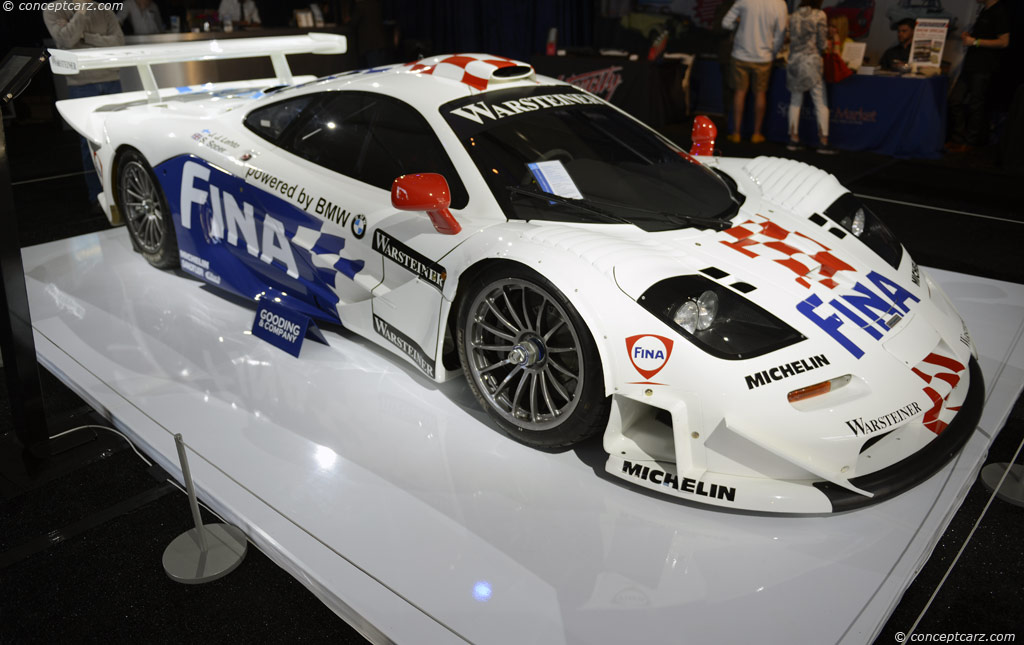
Coupe
Chassis #: 21R
View info and history
Auction entries : 1
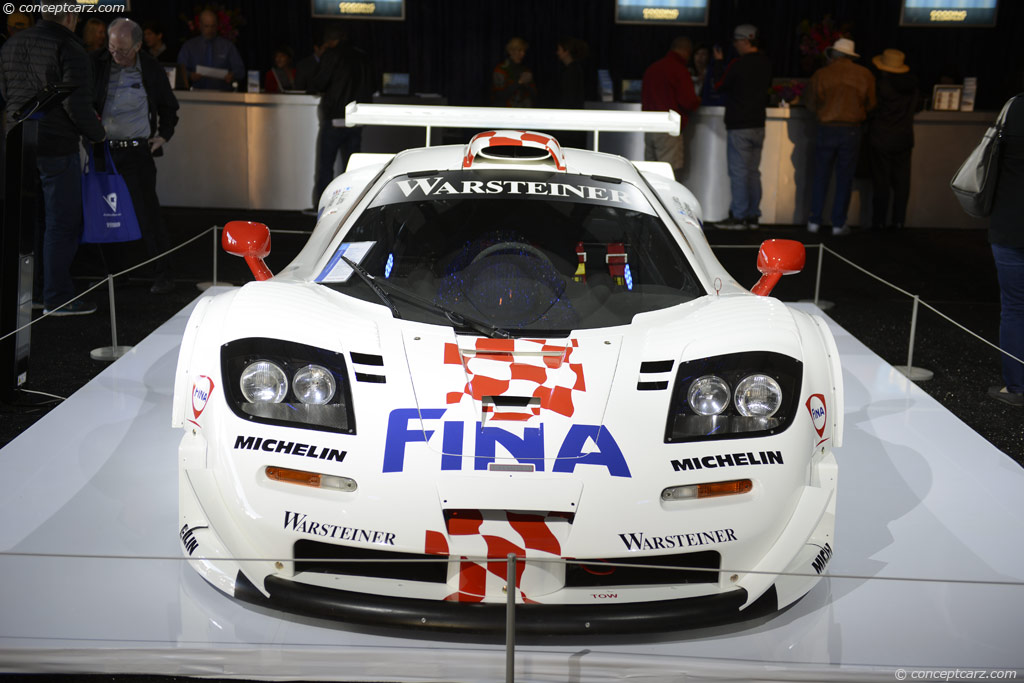
Coupe
Chassis #: 21R
View info and history
Auction entries : 1
The BPR Global GT Series operated from 1994 to 1996 and used production sports cars that were modified into racing cars. Rules required manufacturers to build a certain number of production cars for sale, with the number of homologation vehicles set by the class in which the car wished to participate. During the 1995 season, there were four classes (GT1 through GT4), shrinking to two in 1996 (GT1 and GT2). The upper classes were reserved for production vehicles that had undergone extensive modifications, including the use of non-production parts.
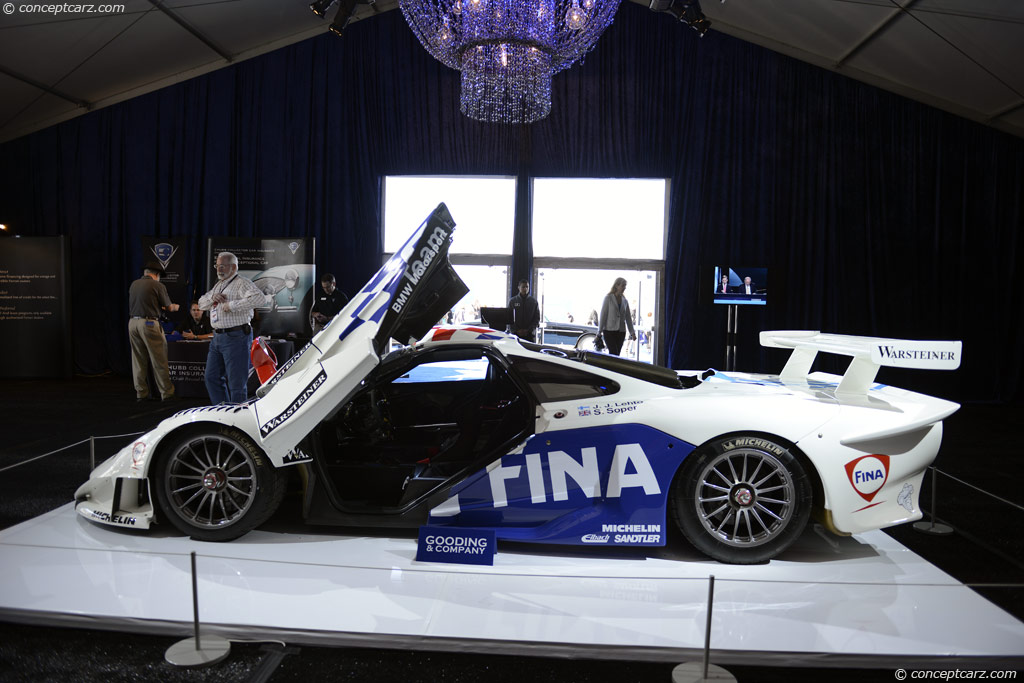
Coupe
Chassis #: 21R
View info and history
Auction entries : 1
The McLaren F1 was designed to be the best road-going sports car in the world and was never intended for competition, but priorities changed with the introduction of the BPR Global GT Series in 1994. This new series was an international endurance racing championship for production-based sports cars, and with mounting pressure from BPR organizers and well-funded private teams, Murray finally agreed to develop the F1 into a racing car. As expected from such a sophisticated machine, the race-prepared McLaren F1s dominated BPR's GT1 category, winning the championship in 1995 and 1996. After the 1996 season, the BPR Global GT Series reformed into the FIA GT Championship, and the regulations were altered to allow a new breed of GT1 car. Thus, the McLaren would have to compete directly with homologation specials like the Porsche 911 GT1 which had been designed especially for endurance racing. This meant more development work for the F1 GTR, which ultimately led to the creation of the F1 GTR 'Longtail.' Transforming the F1 into the F1 GTR
Although designed for the road, the McLaren F1 was built similarly to a race car, and did not require extensive modification to actually transform it into a racing car. An adjustable fixed wing was added to the rear of the car, and various cooling ducts were added, most noticeably a large one in the center of the nose. Two additional cooling ducts were placed in the location of the storage lockers on the side of the car.
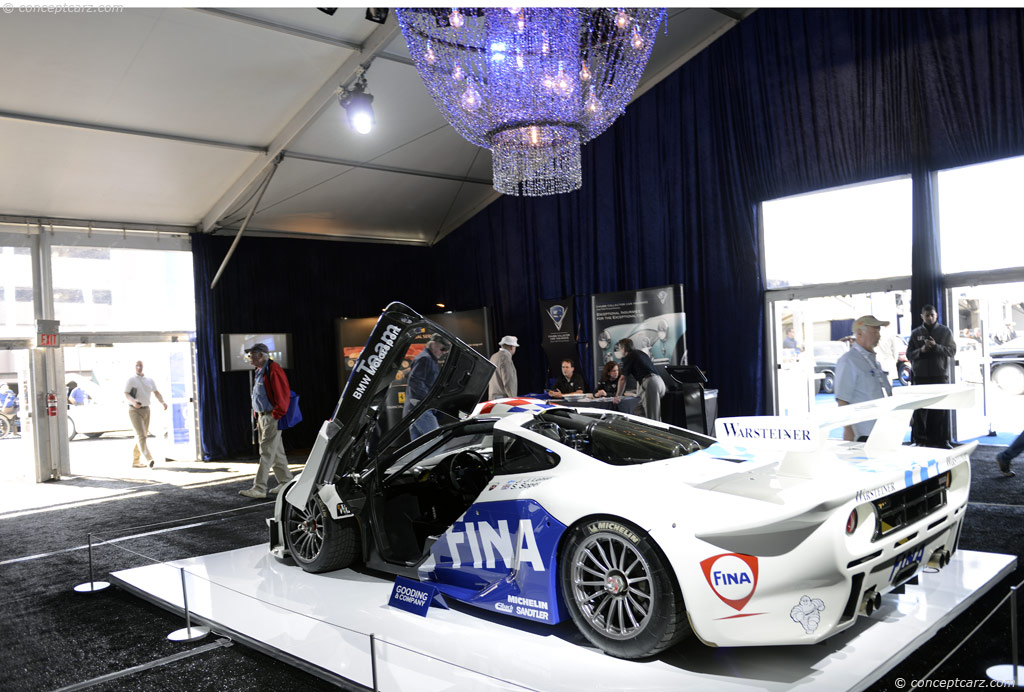
Coupe
Chassis #: 21R
View info and history
Auction entries : 1
The road-going McLaren F1 was powered by a 6,064cc 60-degree V12 engine designed and built by engine expert Paul Rosche, head of the BMW M motorsport division. Called the BMW S70/2, it had dual overhead camshafts with variable valve timing, a chain drive for the camshaft, dry sump oil lubrication, 11:1 compression, two Lucas injectors per cylinder, and produced 618 horsepower at 7,400 RPM and 479 lb-ft of torque at 5,600 RPM. Magnesium castings were used for the dry sump, oil sump, cam carriers, covers, and housings for the camshaft control. Gold foil was used to line the engine bay as a heat reflector, and each car had approximately 16 g of gold. Each cylinder bore received a Nikasil coating for greater durability. The F1 GTR engine was required to use an air restrictor due to racing regulations at the time. This limited output to 592 horsepower (600 PS / 441 kW0), which meant it was less powerful than its road-going sibling. Due to its lower overall weight and aerodynamic modifications, the F1 GTR was faster and more nimble than the more powerful F1 road car.
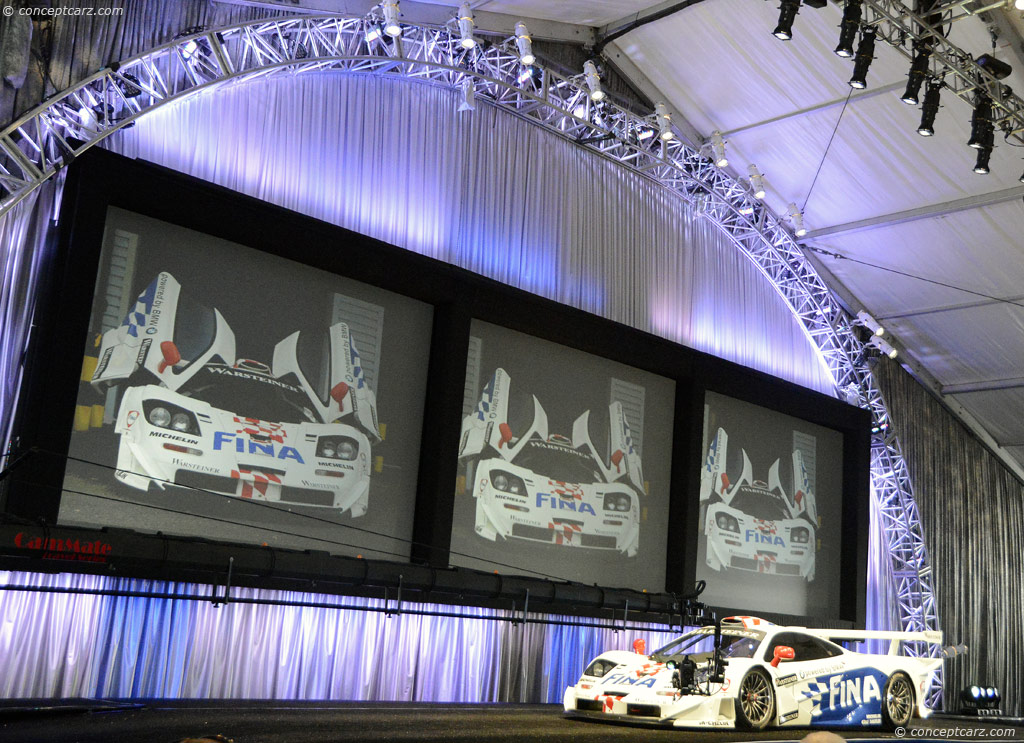
Coupe
Chassis #: 21R
View info and history
Auction entries : 1
McLaren built nine chassis for 1995, with chassis number 01R being the prototype. It was retained by the factory as a test mule and was used during a 24-hour test at Magny-Cours before the start of the season. Its sole competitive outting was at LeMans in 1955 when it was raced by Kokusai Kaihatsu Racing to overall victory. It also set the highest practice top speed of the year, achieving 174.605 mph on the Mulsanne Straight. F1 GTR Racing Chassis
The British team GTC Racing initially received two F1 GTRs, then a third to replace a destroyed car. BBA Competition, Mach One Racing, David Price Racing, and Giroix Racing Team each received a single chassis, and the final chassis (chassis number 09R) was sold to the Sultan of Brunei (Hassanal Bolkiah), for his car collection.
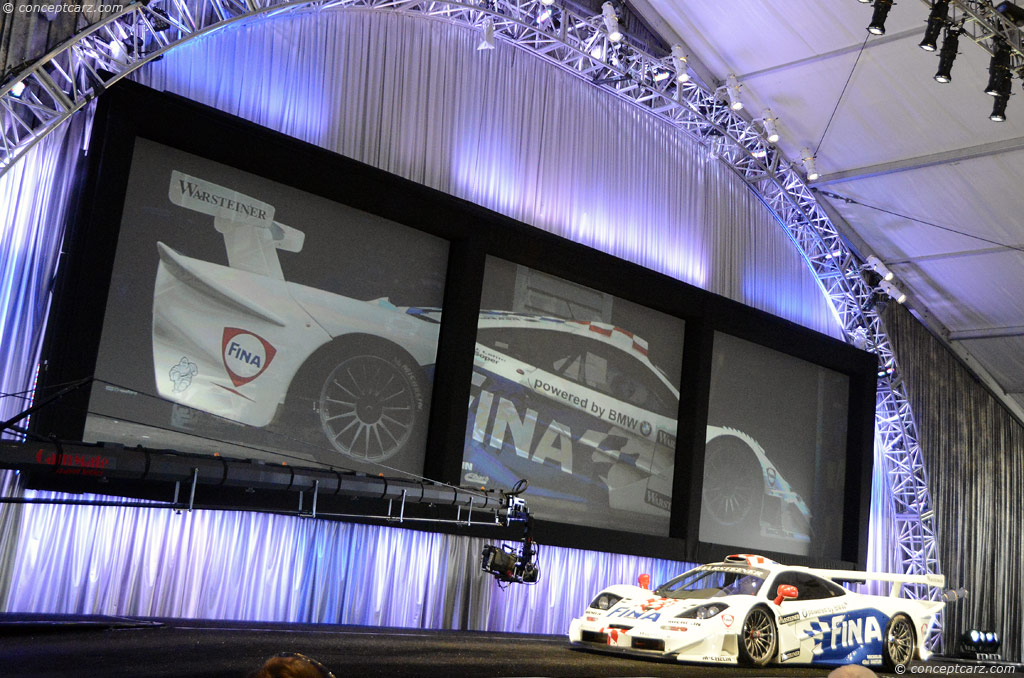
Coupe
Chassis #: 21R
View info and history
Auction entries : 1
Increased competition and rule changes birthed a dramatically different F1 GTR for the 1997 season. Porsche had its 911 GT1, Mercedes-Benz its CLK-GTR, Lotus its Elise GT1, and Panoz its Eserante GTR-1. With the FIA's taking control of the BPR Global GT Series, the GT1 class rules were altered. In addition to the ten F1 GTRs built to take advantage of the new rule changes, McLaren was forced to build an additional three production road cars (known as the F1 GT) using the 1997-spec GTR bodywork. The 1997-spec GTRs are commonly known as the 'Long Tail' due to their elongated bodywork, especially at the rear.
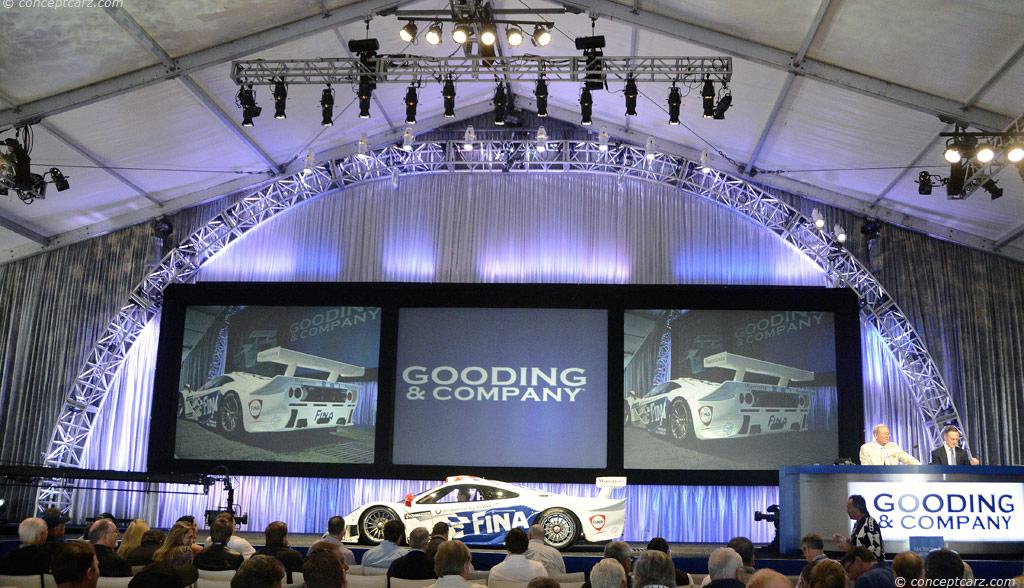
Coupe
Chassis #: 21R
View info and history
Auction entries : 1
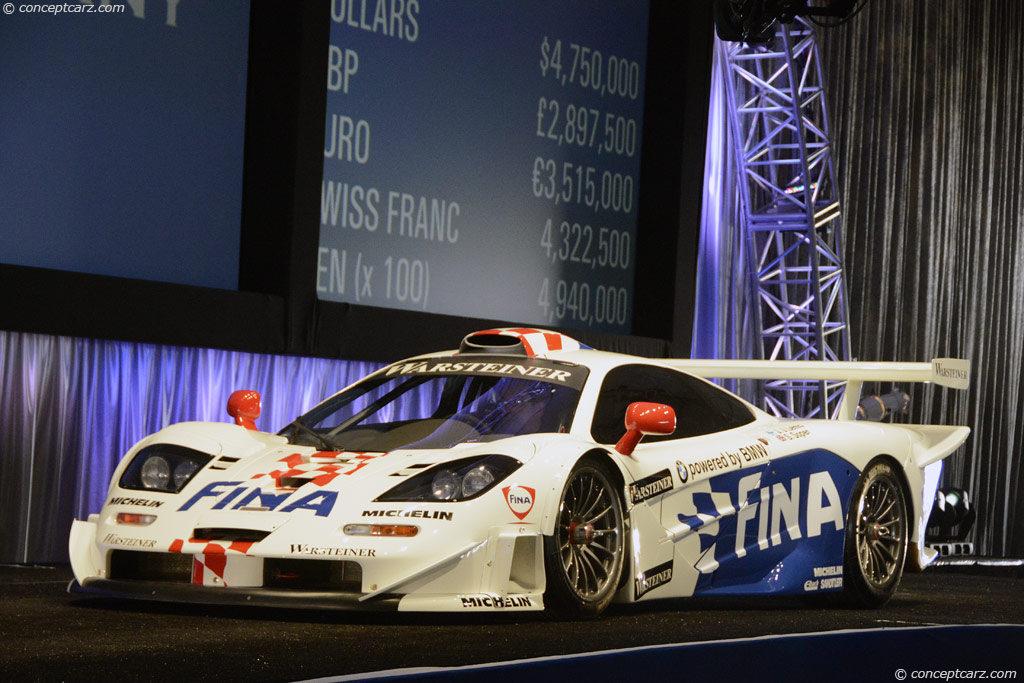
Coupe
Chassis #: 21R
View info and history
Auction entries : 1
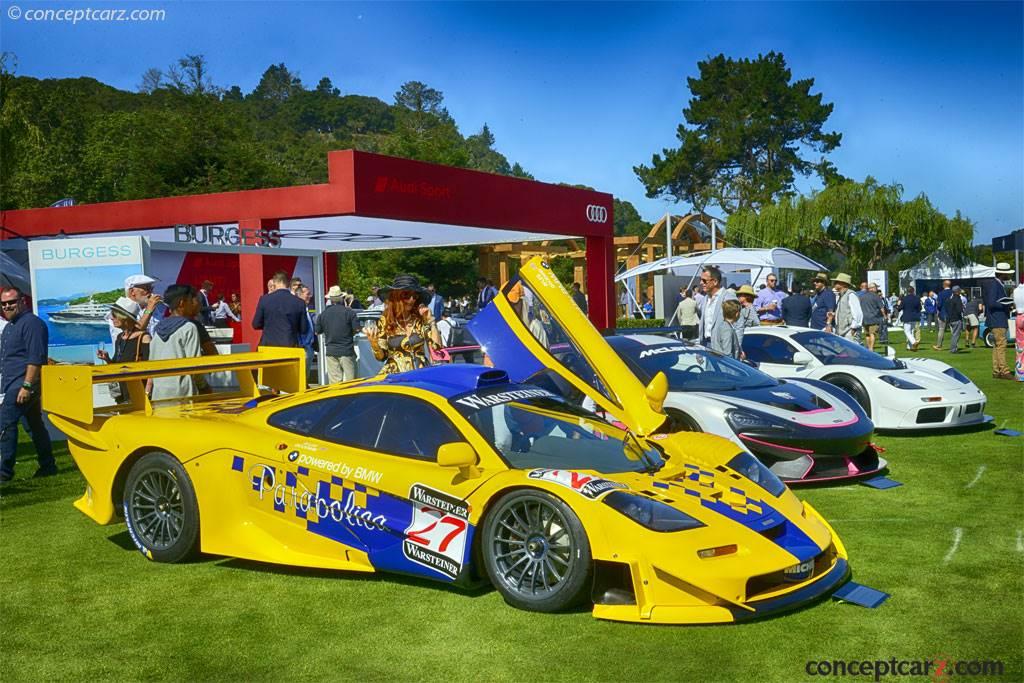
Coupe
Chassis #: 027R
View info and history
Along with the BPR Global GT Series and the FIA GT Championship, the McLaren F1 GTR also contested the All Japan Grand Touring Championship (in 1996, 1999, 2000, 2001, 2002, and 2003) and the BRDC GT Championship (in 1996, one race in 1997, 1998, and 1999). As previously stated, the F1 GTR also raced (and won) the 24 Hours of Le Mans, which was officially not part of any one racing series. At Le Mans, the F1 GTR competed against a variety of cars, including GT1 competitors, unique cars that only raced at Le Mans, and competitors from various series.
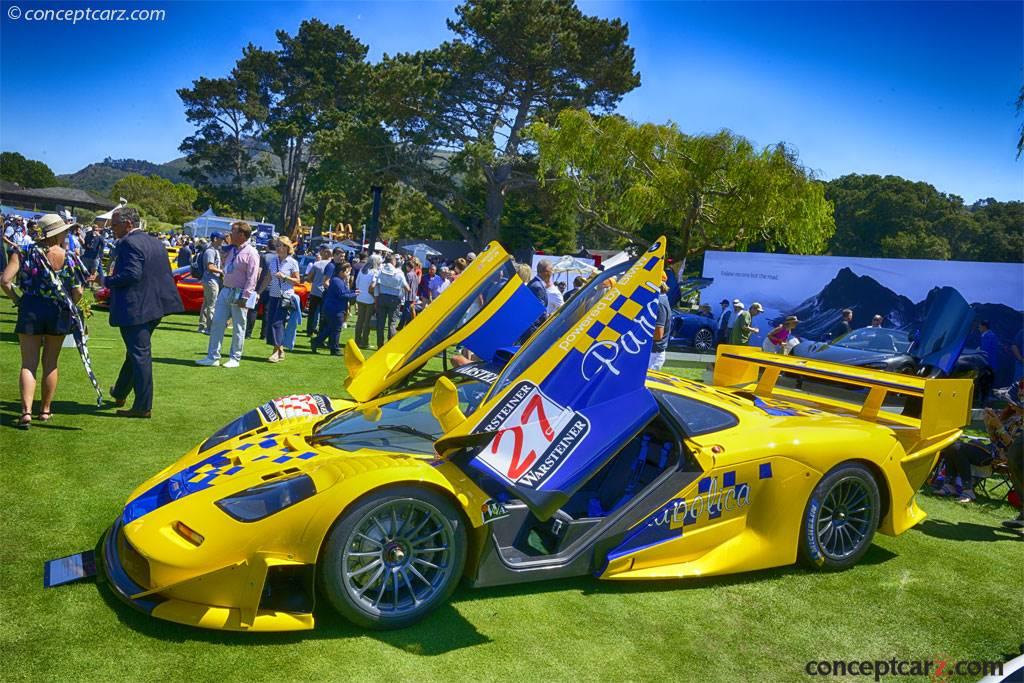
Coupe
Chassis #: 027R
View info and history
Created as an alternative to the international FIA GT Championship and combining elements of the former BPR Global GT Series, the GTR Euroseries raced just one season - 1998. It was created by Patrick Peter and the GTR Organisation, former founders of the BPR. It retained elements of the BPR Global GT Series, such as the class structure (GT1, GT2, GT3, and GT4), all events being four hours in length, and a ban on direct manufacturer input. Instead, this series was intended for small private teams who were seeking alternatives to the high-cost FIA GT series. Thomas Bscher won the first round of the season in Jarama in a McLaren GT GTR (GT1 class competitor). The next race did not feature the McLaren, and by the third round, most of the competition was with the GT2 and GT4 classes. The number of competitors dwindled during the middle part of the season, with a slight revival of 19 cars showing up at the final round (again, mostly GT2 and GT4 teams). Team Davidoff contested this final race of the Euroseries, but retired prematurely due to a blown head gasket. After five rounds, the GTR Euroseries was canceled due to a lack of interest.The All Japan Grand Touring Championship
Team Goh of Japan acquired a pair of F1 GTRs (1996-spec | chassis number 13R and 14R) to contest the All Japan Grand Touring Car Championship's (JGTC) GT500 class under the name Team Lark. The opening round of the series was at Suzuka Circuit, with the Lark team taking the top two spots, with winners Naoki Hattori and Ralf Schumacher. Lark McLaren won the following round at Fuji, with drivers David Brabham and John Nielsen. McLarens were outpaced in the next two rounds, but the final two rounds of the season were won by Team Lark. At Sugo, one of the McLarens had been badly damaged, so chassis number 04R was borrowed from GTC Competition as a replacement for the final JGTC round.Team Lark won the GT500 teams championship with its four victories. The team did not return to defend its title in 1997, and no McLarens contested the series. Team Take One raced during the 1999 season in the GT500 class with a McLaren F1 GTR (#19R, a 1997-spec car). Its best finish during the season was a 9th place at Mine Circuit.Team Take One and Hitotsuyama Racing raced in the series during 2000, with the latter using F1 GTR (#25R / 1997-spec), which they had previously used in the 1999 Le Mans Fuji 1000km. Their best finish was a fourth-place at TI Aida. Both teams returned in 2001, with the Take One McLaren outperforming the Hitotsuyama entry in most rounds. At the final race of the season, at the Mine Circuit, the F1 GTR of Take One McLaren outpaced the Nissan Skyline GT-R to claim overall victory. Team Take One would finish the season 8th in the teams championship.During the 2002 season, Hitotsuyama finished 3rd at Motegi. Team Take One left at the end of the disappointing season. Hitotsuyama returned in 2003 with a best finish of 9th. They retired at the end of the season but returned in 2005 to contest two races. They failed to finish in the first race at Fuji, then placed 18th at Fuji.BRDC GT Championship
Having acquired a former GTC Competition F1 GTR of 1995-spec, Lanzante Motorsports team raced in the 1996 BRDC GT Championship. They would sit on pole position six times yet struggled through most races, earning just a single victory. Lanzante abandoned the McLaren at the end of the season. A McLaren was raced once by Parabolica Motorsports in 1997.Race changes for 1998 enticed Steve O'Rourke's EMKA Racing to compete with a 1997-spec chassis. They were later joined by Team Carl at Silverstone. EMKA earned two race victories, and drivers Tim Sugden and Steve O'Rourke would take second in the overall drivers championship.EMKA Racing and AM Racing (using a 1997-spec car) competed during the 1999 season, with AM Racing being forced to drop out halfway through the season. EMKA scored one victory.Conclusion
Like the road-going F1, the racing F1 GTR was the result of an uncompromising pursuit to create automotive perfection. In all variations, the McLaren F1 was built with meticulous attention to detail, engineered with elegance, assembled with precision, and used the finest and most exotic materials available. Lightweight, nimble, balanced, and refined, the McLaren F1 and its variants were just as capable on a closed circuit as it is on city streets.
by Daniel Vaughan | Sep 2023
GT Vehicles
Similar Automakers
1997 McLaren F1 GTR Longtail Vehicle Profiles
Recent Vehicle Additions
Related Automotive News

The Celebration of 50 Years of M Continues at Monterey Car Week
First public event appearance of the 2023 M4 CSL at Legends of the Autobahn
Rolex Monterey Motorsports Reunion celebrating 100th Anniversary of 24 Hours of Le Mans with four classic BMW race cars
First-ever Corkscrew Hillclimb Shoot-Out at Weather...

THE McLAREN F1
FOR THE DRIVER VITALLY – AS IN ONE OF McLARENS WORLD CHAMPION RACING CARS – DRIVER AND VEHICLE BECOME ENTIRELY AS ONE
The primary design consideration for the McLaren F1 has been to make it without reserve a drivers car, an extremely high-performance...
RRDC VOTES IN 26 NEW MEMBERS FOR 2015
HILLIARD, Ohio (Oct. 23, 2015) - Twenty-six race-car drivers and motorsports professionals have been voted into the Road Racing Drivers Club in 2015. The group includes 11 Regular Members from the open-wheel and sports-car racing ranks, 10 Associate...

Honda Civic Type R Concept Model set for Worldwide Debut at the 2014 Geneva Motor Show
Honda today reveals its 2014 Geneva Motor Show line-up, including the worldwide debut of the Civic Type R Concept model, the European debut of the Fuel Cell Electric Vehicle (FCEV) Concept, the powertrain layout of the new NSX and the 2014 Civic World...

1967 German Grand Prix: Ickx Just Playing with the Big Boys
As the usual immense crowd gathered around the Nuburgring for the 1967 German Grand Prix, just a casual glance at the grid would not tell the real story. However, it wouldnt take too long before the crowd would begin to take notice of a Formula 2 car...




















